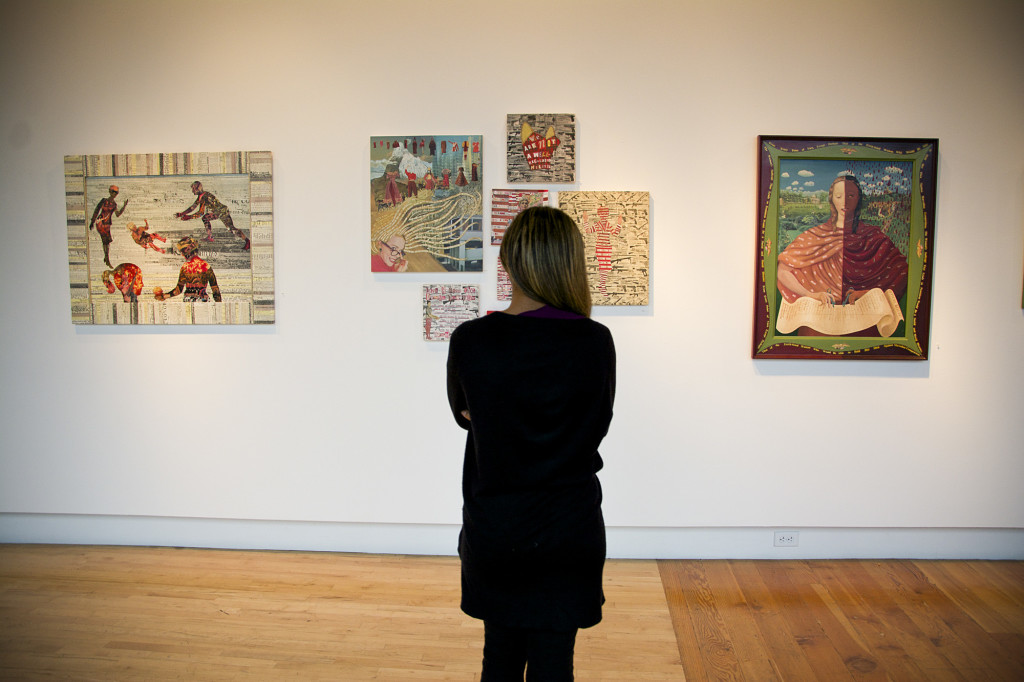At the height of the modern art movement, with its revolutionary thought and rebellious perspectives, a radical creative medium emerged — collage art. This artistic expression challenged traditional artistic ideologies with its limitless range of materials and subjects. Collage quickly became established as a groundbreaking new art form.
To honor the artistic method, curator Amanda Manitach couples the distinctive styles of collage artists Monica René Rochester and Deborah Faye Lawrence in the Hedreen Gallery’s latest exhibition, Discordia.
Though Lawrence and Rochester utilize the same celebrated artistic medium, their artworks convey a completely different range of themes and incite nearly opposite reactions within the viewer.
By contrasting these artists’ distinct approaches, Manitach showcases the many ways in which collage serves as a powerful avenue for creative expression. She describes both collagists as using “paratactic” techniques, which pair two unrelated images or words, asking the viewer or reader to draw connections between the two.
Rochester says she exhibits this technique in her juxtaposition of original imagery as she depicts her own unconscious mind. Her art possesses an inherent tenderness that leads viewers to a deeply contemplative place as they take in the intricate details of her alternate worlds.
Rochester’s self-proclaimed “meditative” creative process involves thoughtfully gathering the elements that will represent her visual autobiographies. As a self-taught artist, Rochester uses dream transcription, surrealist gestures and subliminal messaging to create an extensive collection of collages addressing a variety of feelings and events that are completely unadulterated.
Her work is earnest and authentic both in the thematic content she addresses and the physicality of the collages themselves. All the paper-products Rochester uses in her pieces are vintage or antique, the most recent dating back to the 1980s and the oldest from the early nineteenth century.
On her website, Rochester calls collage an art that is “akin to transcribing the dream state — another way of dreaming — and each picture contains myriad interpretations.” She explains that this outlook on the medium is critical in understanding some of the intended ideas in Rochester’s work as she uses allegorical figures to describe people in her own life.
But this openness about her personal life does not leave Rochester feeling overly-exposed, instead she explains, “It’s makes it easier for me to have it all out there for everyone to see… I could tell the stories about these but so could anyone… This is who I am.”
When asked if the creation of her art is a form of catharsis, Rochester wholeheartedly agreed, saying that, “the greatest pleasure in my life is finishing one of these pieces and seeing it in front of me.”
In contrast to Rochester’s deeply psychological and subliminal world, Lawrence’s work is profoundly political and satirical. Depending on the particular piece, she blends well-known and recognizable imagery depicting the status quo with confrontational, almost combative text, thus exposing the grotesqueness of the original meaning. This transforms the overall piece into a parody of the many injustices perpetuated by societies of the past and present.
Lawrence mixes her own written perspective with that of other sources. She describes her use of text as “a framing device and decorative complement to imagery, as well as a tool of propaganda.”
She describes her decision to work in the medium of collage specifically as a means of relating to her viewer. She sees collage as a “populace movement and inherently democratic.” Because it is a medium at which many people can excel, she feels that collage lends a certain degree of empowerment to the viewer. With these feelings of possibility, Lawrence invites (or demands, as some might argue) her audience to recognize the power of their perspective and their role in advocacy for social justice issues.
Though her art remains open to interpretation, the pieces installed in the Discordia exhibit address a rich array of topics including America’s dominant presence in the global economy, feminist issues relating to the repression of analytical thought, and the limited perspective of what an artists should be — to name a few.
Discordia is the name of a twentieth century ideology that praises chaos and anarchy. It glorifies a place that is in-between somewhere and nowhere, neither a utopia nor a dystopia. Both Rochester and Lawrence use collage to form associations, ones that can only be understood by recognizing what they are not.
The Discordia exhibition will be open until Jan. 12 in the Hedreen Gallery.









